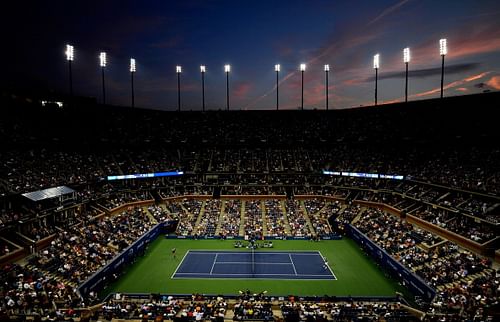
The US Open: Can it keep its unpredictability with a new roof?

A general view of Arthur Ashe Stadium during the men’s singles second round match between Lleyton Hewitt of Australia and Juan Martin Del Potro of Argentina on Day Five of the 2013 US Open at USTA Billie Jean King National Tennis Center on August 30, 2013 in the Flushing neighborhood of the Queens borough of New York City. (Photo by Maddie Meyer/Getty Images)
New York City has a simmering presence in popular culture. That presence is helped by the fact that it is in the United States of America, a country not oblivious to its own ‘superpower’ status. The U.S Open at the Flushing Meadows happens to be the flavour of the month, and questions surrounding the whereabouts of an absent roof have only escalated with time.
The announcements of installing a roof by 2016 is nothing new to the ears of the avid fan; it’s a defying testament of today’s times by the officials at the U. S Open in trying to keep the tournament exclusively outdoors and keep the unstable, uncontrollable environment of the Open alive.
It’s clear that getting a roof has never been a topic of competition, because if it was, then the United States would have made a point to not lag behind its competitors. It’s not going to be an innovation either. Installing a roof can have its own pros and cons.
I’ll start with the positives that are in store. As already announced, the Arthur Ashe Stadium and the Louis Armstrong Stadium are going to have a roof installed. That leaves the other blue hard courts to be witnesses to the heavens dissent. But with those two installations, the predictability level of the matches they host rises. We can see the players play for the entire scheduled duration of the match with no rain to interfere. The audience in the stadium and watching at home get to see an uninterrupted, continuous match. The predictability level can increase ticket sales and enhance the tournament’s economy.
Now, two and only two stadiums can boast of controlling the weather in their grips.
This is important while looking at the cons. The Arthur Ashe Stadium has a capacity of 22,000, making it the largest tennis arena in the world, and according to Reuters, the opening or closing of the retractable roofs can take five minutes. That brings into question how the roofs will be used.
Use of the roof does mean some interruption, even for five to ten minutes. If there are signs of rain, will they immediately seal it up or will they wait for the initial few droplets to follow gravity and then make a move? If the matches in these stadiums are scheduled in such a way as to have players who are higher seeds or popular etcetera, what does that mean for the other courts? Those courts can really test the temperament of the player. It can be a great platform to discover and display one’s skills.
The weather conditions are part of the drama, though. Where it is a furious setback for one player, it can be a calming relief for another. The changing positions of the sun and the succeeding shadows, the giant stroke of the wind, and the transition from sunny to windy- it is all part of the fun.
And this happens in a city like New York, which is high on its die hard spirit and exemplifies the different shades of America, hence providing this chaotic emotional intensity which is found lacking in other tournaments. Perhaps because people come to New York City from all over the world, giving way to an array of fans who show their support in diverse ways. They’ll dance, they’ll sing and in their chaos too they can follow order.
The dramatic thing to say right now will be that for a city which rose above the destruction, misery and hardships caused by 9/11 and the recent hurricane, a little rain can do no harm in dampening their spirits. But as following the trend of installing roofs have now become protocol, the U. S Open having two roofs is not as harmful as well. With this process the move towards a more predictable environment begins, and I just hope that the other roof-less courts carry the tradition of unpredictability forward. Long live the drama!